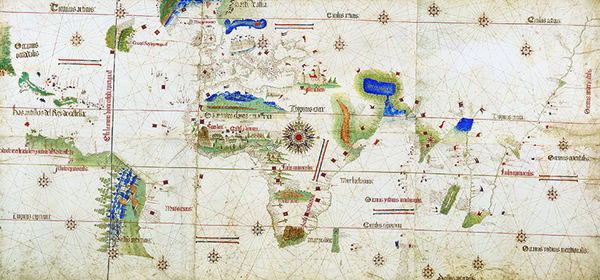| << Chapter < Page | Chapter >> Page > |
The 1492 Columbus landfall accelerated the rivalry between Spain and Portugal, and the two powers vied for domination through the acquisition of new lands. In the 1480s, Pope Sixtus IV had granted Portugal the right to all land south of the Cape Verde islands, leading the Portuguese king to claim that the lands discovered by Columbus belonged to Portugal, not Spain. Seeking to ensure that Columbus’s finds would remain Spanish, Spain’s monarchs turned to the Spanish-born Pope Alexander VI, who issued two papal decrees in 1493 that gave legitimacy to Spain’s Atlantic claims at the expense of Portugal. Hoping to salvage Portugal’s Atlantic holdings, King João II began negotiations with Spain. The resulting Treaty of Tordesillas in 1494 drew a north-to-south line through South America ( [link] ); Spain gained territory west of the line, while Portugal retained the lands east of the line, including the east coast of Brazil.

Columbus’s discovery opened a floodgate of Spanish exploration. Inspired by tales of rivers of gold and timid, malleable natives, later Spanish explorers were relentless in their quest for land and gold. Hernán Cortés hoped to gain hereditary privilege for his family, tribute payments and labor from natives, and an annual pension for his service to the crown. Cortés arrived on Hispaniola in 1504 and took part in the conquest of that island. In anticipation of winning his own honor and riches, Cortés later explored the Yucatán Peninsula. In 1519, he entered Tenochtitlán, the capital of the Aztec (Mexica) Empire. He and his men were astonished by the incredibly sophisticated causeways, gardens, and temples in the city, but they were horrified by the practice of human sacrifice that was part of the Aztec religion. Above all else, the Aztec wealth in gold fascinated the Spanish adventurers.
Hoping to gain power over the city, Cortés took Moctezuma, the Aztec ruler, hostage. The Spanish then murdered hundreds of high-ranking Mexica during a festival to celebrate Huitzilopochtli, the god of war. This angered the people of Tenochtitlán, who rose up against the interlopers in their city. Cortés and his people fled for their lives, running down one of Tenochtitlán’s causeways to safety on the shore. Smarting from their defeat at the hands of the Aztec, Cortés slowly created alliances with native peoples who resented Aztec rule. It took nearly a year for the Spanish and the tens of thousands of native allies who joined them to defeat the Mexica in Tenochtitlán, which they did by laying siege to the city. Only by playing upon the disunity among the diverse groups in the Aztec Empire were the Spanish able to capture the grand city of Tenochtitlán. In August 1521, having successfully fomented civil war as well as fended off rival Spanish explorers, Cortés claimed Tenochtitlán for Spain and renamed it Mexico City.

Notification Switch
Would you like to follow the 'U.s. history' conversation and receive update notifications?